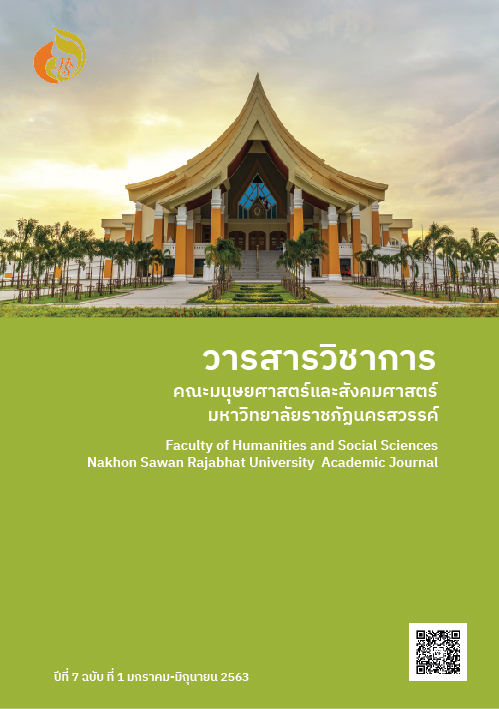การใช้เทคนิคการจัดการเรียนรู้เชิงรุกเพื่อพัฒนาทักษะการนำเสนอของนักศึกษา ในรายวิชาการนำเสนอผลงานทางธุรกิจ
Main Article Content
บทคัดย่อ
การนำเสนอ (Presentation) เป็นวิธีการสื่อสารถ่ายทอดข้อมูลเพื่อให้เกิดความเข้าใจระหว่างผู้ส่งสารและผู้รับสาร การนำเสนอให้ได้รับความสนใจหรือได้รับการอนุมัติ ผู้นำเสนอต้องได้รับการฝึกฝน เนื่องจากเป็นทักษะสำคัญในการทำงานและการดำเนินชีวิต ประกอบด้วย ทักษะ การคิด ทักษะการฟัง ทักษะการพูด ทักษะการอ่าน ทักษะการเขียน และทักษะการถ่ายทอด การพัฒนาทักษะการนำเสนอ (Presentation Skills) จึงต้องให้โอกาสผู้เรียนได้ลงมือปฏิบัติ ด้วยตนเอง ทั้งการนำเสนอด้วยวาจาและลายลักษณ์อักษรด้วยการฝึกรายบุคคล รายคู่หรือกลุ่ม วัดผลจากความสามารถในด้านการพูดและการนำเสนอในรูปแบบต่าง ๆ โดยวิชาการนำเสนอผลงานทางธุรกิจผู้สอนใช้เทคนิคการเรียนรู้เชิงรุก (Active learning) เป็นเครื่องมือในการพัฒนาทักษะดังกล่าวให้กับผู้เรียน โดยผู้สอนต้องสร้างสิ่งแวดล้อมในการเรียนรู้ กระตุ้นผู้เรียนด้วยกิจกรรมกระทั่งผู้เรียนเกิดแนวคิดในการสร้างความรู้ใหม่ด้วยตนเองจากความรู้เดิมที่มีอยู่ ในระหว่างเรียนได้ลงมือปฏิบัติ อภิปราย นำเสนอ พูดคุยโต้ตอบระหว่างกัน ทั้งนี้ผู้เรียนต้องศึกษาเนื้อหาที่เกี่ยวข้องมาล่วงหน้าก่อนเข้าห้องเรียน ดังนั้นผู้สอนจึงต้องเป็นผู้รู้และเชี่ยวชาญในเนื้อหาที่ทันสมัย รู้กระบวนการที่จะพัฒนาวิธีการเรียนรู้ สร้างมาตรฐานการเรียนรู้ รวมถึงการสร้างสิ่งแวดล้อมในชั้นเรียนที่จะกระตุ้นให้ผู้เรียนเกิดการเรียนรู้ และมีการสะท้อนผลการสอนทันทีเพื่อให้ผู้เรียนได้นำกลับไปปรับปรุง
การสอนวิชาการนำเสนอผลงานทางธุรกิจด้วยเทคนิคการเรียนรู้เชิงรุกมุ่งหวังให้ผู้เรียนเกิดการเปลี่ยนแปลงตนเอง มีภาวะผู้นำ กล้าตัดสินใจ เกิดทักษะการเรียนรู้ (Learning Skills) เพื่อนำไปสู่การเรียนรู้ตลอดชีวิต เน้นบูรณาการเชื่อมโยงความรู้ไปสู่การประยุกต์ใช้ในชีวิตจริง ภายใต้กิจกรรมที่หลากหลายโดยผู้เรียนเป็นศูนย์กลาง มีส่วนร่วมในการออกแบบ ฝึกทักษะการคิดระดับสูง และลงมือปฏิบัติด้วยตนเอง ผลลัพธ์ที่ผู้เรียนได้รับคือ เกิดทักษะการนำเสนอ ทักษะการดำรงชีวิต ที่สามารถนำไปปฏิบัติกับการทำงานให้กับองค์กรได้อย่างแท้จริง ในทางเดียวกันผลลัพธ์ที่ผู้สอนได้รับ คือเกิดทักษะการสอน มีความเชี่ยวชาญ ได้เรียนรู้สิ่งใหม่ไปพร้อมกับผู้เรียน ซึ่งเป็นการพัฒนาตน พัฒนางาน และพัฒนาผู้เรียนไปพร้อมกัน
Article Details
เอกสารอ้างอิง
จิตต์ภิญญา ชุมสาย ณ อยุธยา. (2551). ผลการจัดการเรียนรู้แบบเน้นประสบการณ์ที่มีต่อการพัฒนาทักษะสื่อสารของนิสิตปริญญาตรี. วารสารวิจัยทางการศึกษาคณะศึกษาศาสตร์มศว, 8(1).
ชูศักดิ์ เอื้องโชคชัย และคณะ. (2559). คุณลักษณะการเป็นบุคคลแห่งการเรียนรู้ตลอดชีวิตสำหรับเยาวชนไทย. Journal of Education Studies, 44(4), 63-80.
ดิเรก พรสีมา. (2559). ครูไทย 4.0. กระทรวงศึกษาธิการ. สืบค้น 1 พฤษภาคม 2562, จาก http://www.moe.go.th/moe/th/news/detail.php
นนทลี พรธาดาวิทย์. (2559). การจัดการเรียนรู้แบบ Active learning. กรุงเทพฯ: ทริปเพิ้ล เอ็ดดูเคชั่น.
พิมพันธ์ เดชะคุปต์และพเยาว์ ยินดีสุข. (2561). การเรียนรู้เชิงรุกแบบรวมพลังกับ PLC เพื่อการพัฒนา. กรุงเทพฯ: ซีเอ็ดยูเคชั่น จำกัด (มหาชน)
วรพจน์ วงศ์กิจรุ่งเรืองและอธิปจิตตฤกษ์ (แปล). (2554). ทักษะแห่งอนาคตใหม่ : การศึกษาเพื่อศตวรรษที่ 21. กรุงเทพฯ: Open Worlds.
วัฒนา หงสกุล. (2018, June). การจัดการเรียนรู้เชิงรุกในยุคไทยแลนด์ 4.0. In รายงานการประชุม Graduate School Conference (Vol. 1, No. 2, pp. 479-486).
วิจารณ์ พานิช. (2560). วิถีสร้างการเรียนรู้เพื่อศิษย์ในศตวรรษที่ 21. กรุงเทพฯ: มูลนิธิสดศรีสฤษวงศ์.
ศูนย์เทคโนโลยีสารสนเทศและการสื่อสาร สำนักงานปลัดกระทรวงศึกษาธิการ. (2560). แผนการศึกษาแห่งชาติ พ.ศ. 2560-2579. สืบค้น 1 พฤษภาคม 2562, จาก https://www.moe.go.th/moe/th/news/detail.php?NewsID=47936&Key=news20
สุภาพร จตุรภัทร และคณะ. (2561). คุณลักษณะ Soft Skills ที่เป็นที่ต้องการของตลาดแรงงานใน ยุคประเทศไทย 4.0. วารสาร ม จร. อุบลปริทรรศน์, 3(1), 62-80.
สุวมาลย์ ม่วงประเสริฐ และสุภาภรณ์ ตั้งดำเนินสวัสดิ์. (2562). ผลลัพธ์การเรียนรู้และความพึงพอใจของนักศึกษาในหลักสูตรหมวดวิชาศึกษาทั่วไป. วารสารวิชาการบัณฑิตวิทยาลัยสวนดุสิต, 15(1).
อติพร เกิดเรือง. (2562). การส่งเสริมการเรียนรู้ในศตวรรษที่ 21 ของสถาบันอุดมศึกษาไทย. วารสารวิชาการมหาวิทยาลัยราชภัฏลำปาง.
Bonwell, C. C., & Eison, J. A. (1991). Active Learning: Creating Excitement in the Classroom. 1991 ASHE-ERIC Higher Education Reports. ERIC Clearinghouse on Higher Education, The George Washington University, One Dupont Circle, Suite 630, Washington, DC 20036-1183.
Dale Edgar. (1996). Audio-Virtual Methods in Teaching, 3rd ed., Holt, Rinehart & Winston, New York, p.108
Felder, R. M., & Brent, R. (1996). Navigating the bumpy road to student-centered instruction. College teaching, 44(2), 43-47.
Meyers, C., & Jones, T. B. (1993). Promoting Active Learning. Strategies for the College Classroom. Jossey-Bass Inc., Publishers, 350 Sansome Street, San Francisco, CA 94104.
Partnership for 21st Century Skills. (2011). Framework for 21st Century Learning. Retrieved September 1, 2016, From: http://www.p21.org.
Trilling, B., & Fadel, C. (2009). 21 st Century skills: Learning for life in our times. California: John Wiley & Sons.


